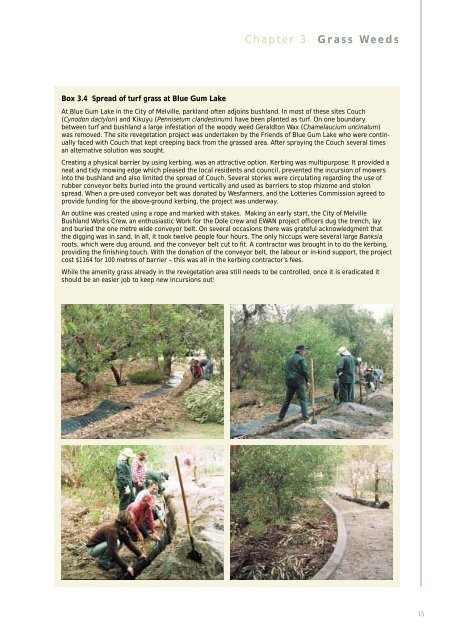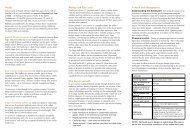Bushland Weeds Manual - Environmental Weeds Action Network
Bushland Weeds Manual - Environmental Weeds Action Network
Bushland Weeds Manual - Environmental Weeds Action Network
Create successful ePaper yourself
Turn your PDF publications into a flip-book with our unique Google optimized e-Paper software.
Box 3.4 Spread of turf grass at Blue Gum Lake<br />
Chapter 3 Grass <strong>Weeds</strong><br />
At Blue Gum Lake in the City of Melville, parkland often adjoins bushland. In most of these sites Couch<br />
(Cynodon dactylon) and Kikuyu (Pennisetum clandestinum) have been planted as turf. On one boundary<br />
between turf and bushland a large infestation of the woody weed Geraldton Wax (Chamelaucium uncinatum)<br />
was removed. The site revegetation project was undertaken by the Friends of Blue Gum Lake who were continually<br />
faced with Couch that kept creeping back from the grassed area. After spraying the Couch several times<br />
an alternative solution was sought.<br />
Creating a physical barrier by using kerbing, was an attractive option. Kerbing was multipurpose: It provided a<br />
neat and tidy mowing edge which pleased the local residents and council, prevented the incursion of mowers<br />
into the bushland and also limited the spread of Couch. Several stories were circulating regarding the use of<br />
rubber conveyor belts buried into the ground vertically and used as barriers to stop rhizome and stolon<br />
spread. When a pre-used conveyor belt was donated by Wesfarmers, and the Lotteries Commission agreed to<br />
provide funding for the above-ground kerbing, the project was underway.<br />
An outline was created using a rope and marked with stakes. Making an early start, the City of Melville<br />
<strong>Bushland</strong> Works Crew, an enthusiastic Work for the Dole crew and EWAN project officers dug the trench, lay<br />
and buried the one metre wide conveyor belt. On several occasions there was grateful acknowledgment that<br />
the digging was in sand. In all, it took twelve people four hours. The only hiccups were several large Banksia<br />
roots, which were dug around, and the conveyor belt cut to fit. A contractor was brought in to do the kerbing,<br />
providing the finishing touch. With the donation of the conveyor belt, the labour or in-kind support, the project<br />
cost $1164 for 100 metres of barrier – this was all in the kerbing contractor’s fees.<br />
While the amenity grass already in the revegetation area still needs to be controlled, once it is eradicated it<br />
should be an easier job to keep new incursions out!<br />
15



